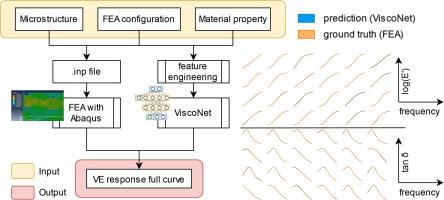ViscoNet: A lightweight FEA surrogate model for polymer nanocomposites viscoelastic response prediction
IF 5
2区 工程技术
Q2 MATERIALS SCIENCE, MULTIDISCIPLINARY
引用次数: 0
Abstract
Polymer-based nanocomposites (PNCs) are formed by dispersing nanoparticles (NPs) within a polymer matrix, which creates polymer interphase regions that drive property enhancement. However, data-driven PNC design is challenging due to limited data. To address the challenge, we present ViscoNet, a surrogate model for finite element analysis (FEA) simulations of PNC viscoelastic (VE) response. ViscoNet leverages pre-training and finetuning to accelerate predicting VE response of a new PNC system. By predicting the entire VE response, ViscoNet surpasses previous scalar-based surrogate models for FEA simulation, offering better fidelity and efficiency. We explore ViscoNet's effectiveness through generalization tasks, both within thermoplastics and from thermoplastics to thermosets, reporting a mean absolute percentage error (MAPE) of < 5 % for rubbery modulus and < 1 % for glassy modulus in all cases and 1.22 % on tan δ peak height prediction. With only 500 FEA simulations for finetuning, ViscoNet can generate over 20k VE responses within 2 min with 1 CPU, compared to 97 days with 4 CPUs via FEA simulations.

ViscoNet:用于聚合物纳米复合材料粘弹性响应预测的轻量级有限元分析替代模型
聚合物基纳米复合材料(PNCs)是通过在聚合物基体中分散纳米粒子(NPs)而形成的,这就形成了聚合物相间区,从而推动了性能的提高。然而,由于数据有限,数据驱动的 PNC 设计具有挑战性。为了应对这一挑战,我们推出了 ViscoNet,这是一种用于 PNC 粘弹性(VE)响应有限元分析(FEA)模拟的替代模型。ViscoNet 利用预训练和微调加速预测新 PNC 系统的 VE 响应。通过预测整个 VE 响应,ViscoNet 超越了以前基于标量的有限元分析模拟代用模型,提供了更好的保真度和效率。我们通过在热塑性塑料内部以及从热塑性塑料到热固性塑料之间的通用化任务来探索 ViscoNet 的有效性,结果表明,在所有情况下,橡胶模量的平均绝对百分比误差 (MAPE) 为 5%,玻璃模量为 1%,tan δ 峰高预测为 1.22%。只需 500 次有限元分析模拟进行微调,ViscoNet 就能在 2 分钟内用 1 个 CPU 生成超过 20k 个 VE 响应,而通过有限元分析模拟使用 4 个 CPU 则需要 97 天。
本文章由计算机程序翻译,如有差异,请以英文原文为准。
求助全文
约1分钟内获得全文
求助全文
来源期刊
CiteScore
9.80
自引率
9.40%
发文量
276
审稿时长
52 days
期刊介绍:
The aim of Journal of The Mechanics and Physics of Solids is to publish research of the highest quality and of lasting significance on the mechanics of solids. The scope is broad, from fundamental concepts in mechanics to the analysis of novel phenomena and applications. Solids are interpreted broadly to include both hard and soft materials as well as natural and synthetic structures. The approach can be theoretical, experimental or computational.This research activity sits within engineering science and the allied areas of applied mathematics, materials science, bio-mechanics, applied physics, and geophysics.
The Journal was founded in 1952 by Rodney Hill, who was its Editor-in-Chief until 1968. The topics of interest to the Journal evolve with developments in the subject but its basic ethos remains the same: to publish research of the highest quality relating to the mechanics of solids. Thus, emphasis is placed on the development of fundamental concepts of mechanics and novel applications of these concepts based on theoretical, experimental or computational approaches, drawing upon the various branches of engineering science and the allied areas within applied mathematics, materials science, structural engineering, applied physics, and geophysics.
The main purpose of the Journal is to foster scientific understanding of the processes of deformation and mechanical failure of all solid materials, both technological and natural, and the connections between these processes and their underlying physical mechanisms. In this sense, the content of the Journal should reflect the current state of the discipline in analysis, experimental observation, and numerical simulation. In the interest of achieving this goal, authors are encouraged to consider the significance of their contributions for the field of mechanics and the implications of their results, in addition to describing the details of their work.

 求助内容:
求助内容: 应助结果提醒方式:
应助结果提醒方式:


